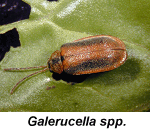| |
|
| |
||||
|
Purple Loosestrife
Purple loosestrife (Lythrum salicaria) is a perennial plant native to Europe. It was brought to North America in the early 1800's by immigrants who valued its striking purple flowers. Seeds were also unintentionally transported to the shores of North America in the ballast water of ships. Since then, purple loosestrife has expanded its range. It is now a serious pest of wetlands and pastures throughout a great deal of North America and Vermont. Once purple loosestrife enters a wetland, it takes over. Common native wetland plants, such as cattails and sedges, cannot compete with purple loosestrife. Once these native plants are choked out, the wildlife that depends on them for food and shelter are also eliminated. Purple loosestrife has little value as food for animals, and populations of the plant become so thick that they cannot serve as cover for wildlife. Purple loosestrife also invades the shallow waters used for northern pike spawning, ruining these areas as spawning grounds. Purple loosestrife reproduces prolifically -- one plant can produce several million seeds in a single summer. In addition, root or stem fragments can take root and form new plants. River water and floods are the primary ways that seeds and plant fragments are transported to new areas. Over 100 insect species feed on purple loosestrife in Europe and Asia. These insects, along with disease, keep purple loosestrife growth under control in its natural habitat. None of these natural enemies are native to North America. Some native plants can be confused with purple loosestrife. Positive identification should be made using the characteristics illustrated on the right. Several methods have been used to fight purple loosestrife. It has been pulled by hand, mowed, treated with herbicides, and burned. These methods have shown some success against small recently established populations; however, they are ineffective against large well-established purple loosestrife populations. In addition, these methods can inadvertently damage native plant communities. 
A new tool, called biological control, has recently become available to aid in the fight against purple loosestrife. Biocontrol works by using a plant's natural enemies against it. In 1992, five insect species which feed on purple loosestrife in Europe were approved as bio-control agents in North America. Approval for the use of these insects followed years of rigorous testing. These tests ensured that the insects would not eat agricultural crops, and that they would not have a significant impact on wetland species other than purple loosestrife. Biocontrol of purple loosestrife began in Vermont in 1995 with the release of three European insect species (two leaf-eating beetles, and one stem boring weevil) by the U.S. Fish and Wildlife Service. In July 1996, the Vermont Department of Environmental Conservation began releasing two species of leaf-eating beetles (Galerucella spp.). Since 1996, approximately 553,000 beetles have been released into more than 854 acres of purple loosestrife throughout 79 different towns. These beetles will continue to be released and their impact monitored annually. Rutland
Burlington
Get Involved in a Community Rearing Project!
The success of a biological control program is dependent on many factors. Public support and the number of biological control agents a program can raise and distribute are two such factors. While there is public support for the biological control of purple loosestrife in Vermont, the number of beetles reared and released is currently limited by space at the Waterbury rearing compound, a staff number of two, and a limited budget. Other purple loosestrife biological control programs have overcome the same obstacles by harnessing public support and forming community rearing programs. Community rearing works by allowing community members or groups to raise, release and monitor Galerucella spp. beetles. The Vermont Purple Loosestrife Biocontrol Program has been hosting a community rearing program for the past five seasons. The volunteers in this program have greatly increased the number of beetles released throughout Vermont, and have heightened community awareness about this invasive plant. For more information on how to get involved contact the VTDEC Wetlands Section Additional Information
Updated: October 2005 |
||||
|
|
||||
|
www.vtwaterquality.org
VT DEC |
| DEC
home |
| A
Vermont Government Website Copyright 2003 State of Vermont - All rights
reserved |